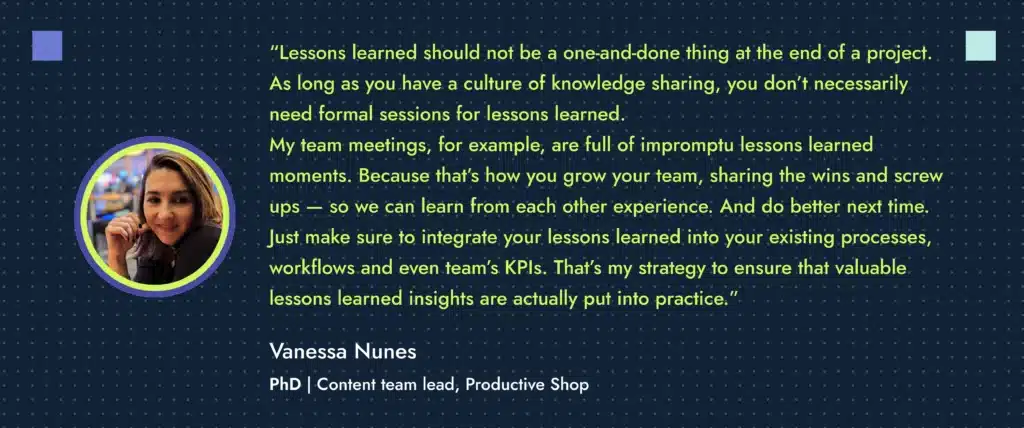I’ll save you time, it’s obviously the dev team’s fault, and if it wasn’t them, sales scoped it wrong. Just joking.
As a B2B SaaS founder, especially in the volatile phase of seed to series A funding, reflection and iterative learning are critical to your growth and customer retention. Every decision, big or small, can dramatically influence your startup’s trajectory. This is where the value of a lessons learned/project retrospective session comes into play. Here’s how to get the most out of such meetings:
1. Clarify your aim
Defining the primary objective of your lessons learned session is the first step towards ensuring its success. It shapes the conversation, keeps discussions on track and ensures outcomes align with your strategic vision. See the common scenarios (by team activity).
- Product feature rollout: If your SaaS platform recently launched an AI-powered recommendation system, your objective could be: “Evaluate the effectiveness of the AI recommendation engine in improving user engagement over the past month.” This narrows the discussion down to user feedback on this feature, the technical challenges faced and its ROI in terms of user activity and satisfaction.
- Marketing campaign review: Let’s say you’ve recently wrapped up a three-month-long content marketing campaign aimed at increasing sign-ups. Your session’s focus could be: “Assess the performance of our content marketing strategy in Q2 and identify areas for improvements for Q3.” The conversation would then revolve around metrics like engagement rates, lead conversion and content quality.
- Sales strategy analysis: If your sales team shifted from cold calling to primarily LinkedIn outreach, your aim might be: “Determine the efficacy of our new LinkedIn outreach strategy in generating sales qualified leads compared to traditional methods.” This would involve examining lead quality, outreach-to-meeting conversion rates and feedback from potential clients.
- Customer support evaluation: Suppose you introduced a chatbot to assist with user queries. The objective could be: “Assess the efficiency and user satisfaction of the new chatbot support system over the last quarter.” Focus areas would include bot response time, resolution rate and feedback collected from users post-interaction.
2. Handpick your project team
Your startup’s size at the seed stage is likely intimate, so make sure key players across product, sales, customer success and tech are in constant communication. The knowledge sharing from various teams’ perspectives ensures well-rounded feedback.
Make sure to involve relevant stakeholders from a project or product release. Don’t drag the whole company into a lessons learned session. You’ll get the chance to share the actioned learning with everyone at the end of the cycle (we will talk about it later on in the article).
🚀 Action it: For an onboarding feature review, invite the UX designer, the lead developer, a customer success representative and a couple of key users.
3. Equip your team with a story
Ahead of the session, share any relevant data or customer feedback. Encourage your team to come with insights and their solutions. All proposed solutions should follow closely the SMART task method and not be vague.
🚀 Action it: Take screenshots of good and bad comments or meeting outcomes throughout the project to understand customer disposition toward your product/project and internal team disposition toward each other.
4. Create a safe space to gather feedback
A Gallup survey found that only three out of 10 U.S. employees believe their opinions count at work. When your team members don’t believe their opinions matter, they may be less inclined to share feedback.
Create an environment where the entire team feels safe to speak up. Here’s how:
- Non-judgmental listening: Encourage everyone to listen actively without immediately jumping to conclusions. For example, if a developer mentions a feature was delayed, instead of assigning blame, first seek to understand the reasons behind the delay.
- Use “I” statements: Promote the use of “I” statements, which are less accusatory and more personal. Instead of saying, “You didn’t meet the target,” one could say, “I felt concerned when we didn’t meet the target.”
- Confidentiality assurance: Make it clear that discussions within the session will not be used against anyone or mentioned outside without consent. This might be crucial when discussing sensitive topics, like conflicts between departments or feedback on leadership.
- Constructive feedback: When offering feedback, ensure it’s solution-oriented. Instead of just highlighting what went wrong, focus on how to make it right next time. For instance, instead of saying, “The marketing campaign was ineffective,” suggest, “Perhaps we can try a different approach or platform for our next marketing campaign.”
- Anonymous input option: Team members might have feedback they’re uncomfortable sharing openly. Providing an anonymous channel, like a feedback box or digital tool, can allow for these concerns to be voiced without fear of retribution.
- Reiterate the purpose: Begin the session by emphasizing the objective is learning and growth, not finger-pointing. This sets a collaborative tone and promotes a culture of learning from the outset.
5. Appoint an impartial moderator
Having an impartial moderator contributes to neutral facilitation. It could be an advisor or a team member who was not closely involved in the completed project. This person ensures everyone is heard and the session stays on track. They do need to be forewarned that emotions may run a tad high and, as a result, they may need to be more judiciously and incisively controlling the meeting direction. They should not allow any team member to hijack it and ensure that quiet voices are also heard.
🚀 Action it: If your CTO was deeply involved in the feature development, maybe a department lead or a project coordinator, who’s slightly removed from the direct creation process, can facilitate.
6. Allocate time wisely
In the startup hustle, time is gold. Depending on your focus, designate an appropriate duration to keep discussions concise and productive — likely two hours. Prep and share an agenda ahead of the project retrospective and make sure to have time allotted to every topic to manage everyone’s expectations.
🚀 Action it: Use a timer to allocate 15 minutes for discussing wins, 25 minutes for pain points and 20 minutes for solutions, keeping the session dynamic.
7. Use a lessons learned template to add structure to your meeting
Structuring a project review meeting ensures clarity, drives continuous improvement and fosters a positive team culture. A well-structured retrospective provides an organized platform for the team to reflect, understand their achievements, identify challenges and collaboratively find solutions, ensuring better project outcomes in the future.
Here’s a project retrospective template to get you started:
- Introduction: Re-emphasize aims and ground rules.
- Example: Start with “The goal today is to review our project, understanding its successes and areas of improvement, while maintaining respect and open dialogue.”
- Wins: Celebrate the positives.
- Example: “Our customer support response time improved by 30% during this project.”
- Pain points: Highlight what didn’t pan out.
- Example: “We missed two key deadlines due to miscommunication between departments.”
- Solutions: Brainstorm improvements.
- Example: “Implementing a centralized communication tool might reduce these oversights.”
- Next steps: Decide on actionable tasks.
- Example: “Sarah will research and propose three communication tools by next week.”
8. Dive deep with questions
Deep diving into questions during a project lessons learned meeting is crucial to extracting detailed, actionable feedback. Broad questions can yield vague or generic answers, lacking the granularity required for genuine improvement. Specific questions illuminate precise issues or successes, enabling teams to accurately pinpoint areas of refinement or replication.
🚀 Action it:
- Instead of asking “Did users like the feature?”, ask “What specific aspects of the feature received the most positive feedback?”
- Instead of asking “Was the project successful?”, ask “Which milestones within the project were achieved ahead of schedule and which faced delays?”
To get you started, see these topic-based retrospective question examples:
- Product alignment: How well did our latest release or feature align with our target users’ needs and pain points?
- Goal achievement: Did we meet our predefined objectives for this project phase and if not, why?
- Efficiency of processes: Were there any bottlenecks in our workflow or development process that delayed the project?
- Team collaboration: How effective was the communication and collaboration between different departments (e.g., development, marketing, sales)?
- Resource utilization: Did we allocate the right resources (time, budget, personnel) effectively, and were there any shortages or overages?
- Customer feedback: What has been the initial feedback from our clients or beta testers regarding the new feature or update?
- Technical issues: Were there any recurring technical challenges or bugs that need to be addressed for future projects?
- Marketing and sales impact: How did our latest campaign release impact our sales and marketing efforts, and what can be improved for better alignment?
- Risk management: Were there any unforeseen challenges or risks during the project, and how effectively did we respond to them?
- Knowledge gaps: Were there any areas where the team lacked knowledge or training, which might have impacted the project’s success?
9. Write down the lessons learned
Appoint someone to jot down vital insights from your project review meeting, particularly tasks you’ll act upon.
🚀 Action it: Use tools like Notion, Google Docs or Box Notes with real-time collaboration features so team members can jointly document insights and takeaways during the session.
10. Detailed action plan? Prioritize!
With limited resources, decide which tasks to tackle first based on impact and feasibility. Here are the three items I consider the most important to keep in mind to help you prioritize what lessons learned areas to tackle first.
- Customer satisfaction
- Internal team retention
- Profitability
🚀 Action it: Use a dot-voting method. Allow every participant to place three sticker dots (or digital equivalents) beside the action items they find most urgent. Tally and prioritize.
11. Assign an owner
Responsibility and clarity of roles ensure that action points derived from a project retrospective meeting don’t fall through the cracks. By assigning specific tasks to particular team members, accountability is ingrained into the process, making follow-through more likely.
Examples by team responsibility:
- Product team: If a lesson learned points towards a usability issue, a product manager can be assigned the task of conducting user testing and refining the product feature.
- Development team: Should the lesson be about a recurring bug or system crash, a developer or a development team lead can be tasked with troubleshooting and resolving the issue.
- Marketing team: If feedback highlights insufficient market awareness despite a campaign, a marketing specialist could be charged with assessing campaign metrics and strategizing a more effective approach.
- Customer support team: If there’s feedback about customers facing challenges with after-sales support, a support team lead might be given the responsibility to refine training modules for the support staff.
🚀 Action it: Use project management tools like Asana or JIRA.
- In the case of the development team, a JIRA ticket can be created detailing the bug, tagging the responsible developer and setting a deadline for the fix.
- In Asana, the marketing specialist can be assigned a task with specifics on re-evaluating the said campaign, complete with deadlines and necessary resources attached.
12. Track progress
Choose a realistic date to revisit action items for completion, about two weeks after your retrospective session should suffice. Continuous monitoring of action item progress ensures you act on the feedback.
🚀 Action it: Schedule a 15-minute stand-up in two weeks to check on the progress of action items. Use tools like Slack reminders to keep everyone on track.
13. Disseminate learnings to avoid project failure
In a Starmind survey, two-thirds of employees said they could have avoided a prior mistake if they had access to the right information. That’s why you should share session outcomes with everyone, including all the templates and processes that have been adjusted as a result of team learning. This step not only ensures alignment across the startup but can also elicit additional insights and feedback that may not have surfaced during the initial session.
Action it: Convert your session notes into a clear email or Slack update, spotlighting the primary takeaways and forthcoming action items for broader team comprehension.
- Sales team: Update your statements of work (SOWs), service level agreements (SLAs) and business discovery question framework to avoid over or under-estimating to ensure clarity with future clients, reducing repetitive points of friction.
- Product development team: Based on user feedback and analytics, iterate on product features to enhance user experience. For instance, if users find a certain workflow confusing, the team should re-evaluate and simplify that user journey to stay true to PLG principles. Maintain a prioritized product backlog, adjusting based on lessons learned reports to ensure the most critical features and fixes are addressed promptly in upcoming sprints.
- Development team: Enhance the handoff procedure from the design team, ensuring UX specifications are clear and actionable. Prioritize maintaining clean code via assistive tech to minimize QA issues.
- Design team: Incorporate consistent design systems and components based on user feedback, and improve the feedback loop with developers to ensure design assumptions on functionality are clearly communicated.
- Quality assurance team: Implement automated testing for recurrent bugs to prevent future regressions and streamline test cases based on the most common user paths.
- Project management team: Update project timelines to incorporate buffer periods for unforeseen changes and enhance communication channels to ensure all stakeholders remain informed about project progress within clearly defined tasks.
- SEO team: Ensure all website changes include SEO considerations from the onset to maintain or enhance organic rankings, create an SEO audit process by which the design team informs SEO on any functionality that may change the URL structure of the site.
- Content team: Adjust content calendars based on user engagement metrics. For example, if blog posts and white papers on a particular topic are receiving higher engagement and form submissions, it might be worthwhile to optimize existing content or produce more content around that area or format.
14. Refine the lessons learned process
Just as startups must iterate on their products and services to achieve the best market fit and continuous business momentum, the same applies to your internal processes, including post-project retrospective sessions.
The sessions shouldn’t become a bureaucratic checkbox. They must become part of a learning culture. Even company retreats are great for lessons learned.
🚀 Action it: After the session, send out a short Slack survey to participants, asking for feedback on the session’s effectiveness and areas of improvement.
Moving forward
In the early stages of seed and series A of a B2B SaaS startup, learning from experiences — both good and bad — can set you apart from the competition. Regular lessons learned sessions not only enhance team cohesion but also provide actionable insights.
By meticulously running these sessions, you stand a better chance at navigating the complex waters of the SaaS industry, ensuring each pivot or decision is grounded in reflection and collective wisdom.
💡For more insights on how to navigate the challenges of B2B SaaS growth, explore our startup series.







